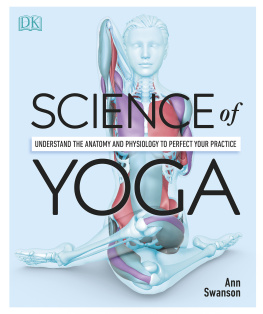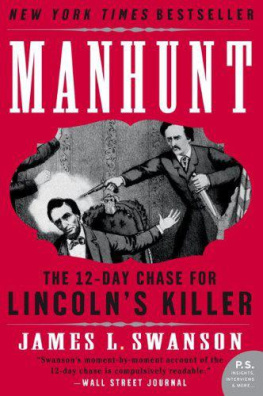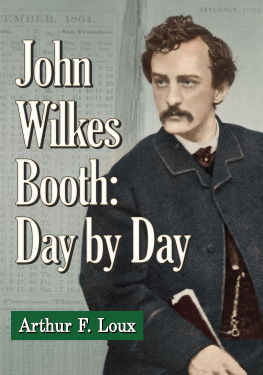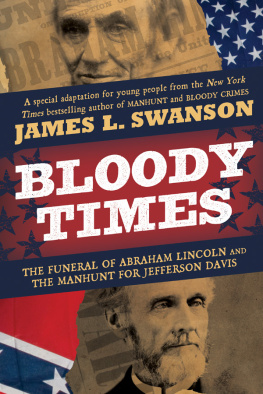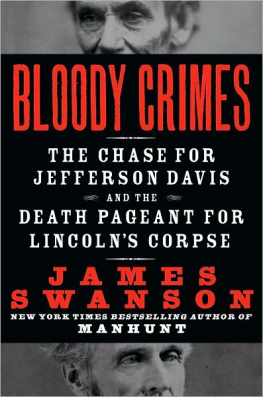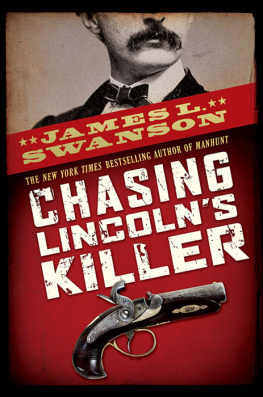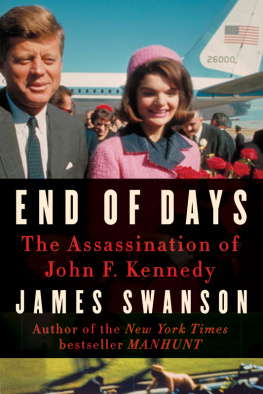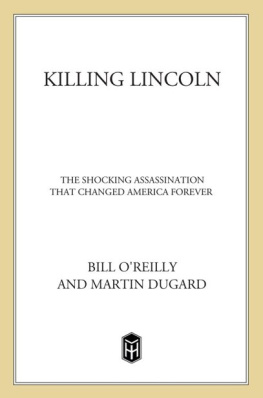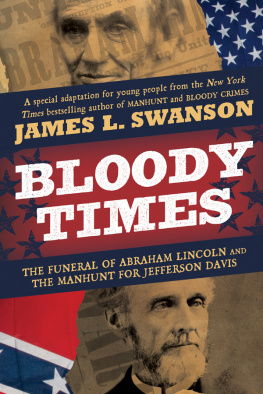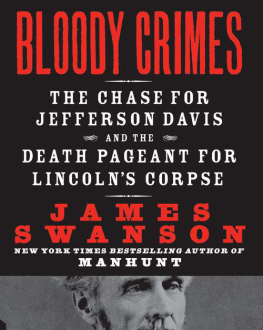Manhunt
The 12-Day Chase for Lincolns Killer
James L. Swanson
For my parents, Lennart and Dianne Swanson
I have never had a feeling politically that did not spring from the Declaration of Independence... that which gave promise that in due time the weights should be lifted from the shoulders of all men, and that all should have an equal chance.... Now, my friends, can this country be saved upon that basis?... If it cant be saved upon that principle... if this country cannot be saved without giving up on that principle... I would rather be assassinated on this spot than to surrender it.
PRESIDENT-ELECT ABRAHAM LINCOLN DURING A SPEECH ON FEBRUARY 22, 1861, TEN DAYS BEFORE TAKING THE OATH OF OFFICE AS THE SIXTEENTH PRESIDENT OF THE UNITED STATES
This mans appearance, his pedigree, his coarse jokes and anecdotes, his vulgar similes, and his policy are a disgrace to the seat he holds... he is... the tool of the North, to crush out, or try to crush out slavery, by robbery, rapine, slaughter and bought armies... a false president yearning for a kingly succession...
JOHN WILKES BOOTH TO HIS SISTER AT A PRIVATE HOME SHORTLY BEFORE PRESIDENT LINCOLNS REELECTION IN NOVEMBER 1864
This story is true. All the characters are real and were alive during the great manhunt of April 1865. Their words are authentic. Indeed, all text appearing within quotation marks comes from original sources: letters, manuscripts, affidavits, trial transcripts, newspapers, government reports, pamphlets, books, memoirs, and other documents. What happened in Washington, D.C., in the spring of 1865, and in the swamps and rivers, and the forests and fields, of Maryland and Virginia during the next twelve days, is far too incredible to have ever been made up.
JAMES L. SWANSON
Booths Escape Route

IT LOOKED LIKE A BAD DAY FOR PHOTOGRAPHERS. TERRIFIC winds and thunderstorms had swept through Washington early that morning, dissolving the dirt streets into a sticky muck of soil, garbage, and horse droppings. Women, for their own safety, were advised to stay indoors. The ugly gray sky of the morning of March 4, 1865, threatened to spoil the great day. One block east of the Capitol Building, a patent lawyer and part-time photographer named William M. Smith set up his camera and pointed its lens at the temporary wood platform that had been hastily erected over the East Front steps. His job was to make a historic photographthe first image ever taken during a presidential inauguration of the recently completed great dome. Smith adjusted his apparatus until his lens framed the panoramic, vertical view, from the low-lying plinth of Horatio Greenoughs marble statue of George Washington on the lawn to the tip top of the dome, crowned by Thomas Crawfords bronze statue of Freedom. Abraham Lincoln had ordered that work on the dome continue during the war as a sign that the Union would go on.
Closer to the Capitol, and standing on another platform, Alexander Gardner set up his camera to photograph the ceremony. Gardners large, glass-plate negatives captured not only images of the president, vice president, chief justice, and other dignitaries occupying the stands, but also the anonymous faces of hundreds of spectators who crowded the East Front scene. One face among them stands out. On a balcony above the stands, standing near an iron railing, a young, black-mustachioed man wearing a top hat gazes down on the president. It is the celebrated actor John Wilkes Booth.
Abraham Lincoln rose from his chair and advanced toward the podium. He was now at the height of his power, with the Civil War nearly won. In one hand he held a single sheet of paper, typeset and printed in double columns. The foreboding clouds threatened another downpour. Then, reported Noah Brooks, journalist and friend of the president, the strangest thing happened: Just at that moment the sun, which had been obscured all day, burst forth in its unclouded meridian splendor, and flooded the spectacle with glory and light. Every heart beat quicker at the unexpected omen... so might the darkness which had obscured the past four years be now dissipated. The presidents text was brief just 701 words.
Fondly do we hopefervently do we praythat this mighty scourge of war may speedily pass away....With malice toward none; with charity for all; with firmness in the right, as God gives us to see the right, let us strive on to finish the work we are in; to bind up the nations wounds; to care for him who shall have borne the battle, and for his widow, and his orphanto do all which may achieve and cherish a just and lasting peace, among ourselves, and with all nations.
Subsequent events would soon change how witnesses recalled Lincolns greatest day. To Noah Brooks, Chiefly memorable in the mind of those who saw that second inauguration must still remain the tall, pathetic, melancholy figure of the man who... illuminated by the deceptive brilliance of a March sunburst, was already standing in the shadow of death.
On April 3, 1865, Richmond, Virginia, capital city of the Confederate States of America, fell to Union forces. It was only a matter of time now before the war would finally be over. The rebellion had been crushed, and the North held a jubilee. Children ran through the streets waving little paper flags that read Richmond Has Fallen, We Celebrate the Fall of Richmond, or Victory Will Lead to Peace: The Right Stripe. Across the country, people built bonfires, organized parades, fired guns, shot cannons, and sang patriotic songs. Four days later, John Wilkes Booth was drinking with a friend, the actor Samuel Knapp Chester, at the House of Lords saloon, on Houston Street in New York City. Booth struck the bar table with his fist and regretted a lost opportunity. What an excellent chance I had, if I wished, to kill the President on Inauguration day! I was on the stand, as close to him nearly as I am to you.
IN RESPONSE TO A THRONG OF SERENADERS WHO MARCHED onto the White House grounds and begged him to address them, Abraham Lincoln appeared at a second-floor window below the North Portico on April 10 to greet this crowd of citizens celebrating General Grants victory at Appomattox the previous day. Lincoln did not have a prepared text, and he was unwilling to speak on a subject of any consequence, including his postwar policy for the South. He resorted to his favorite oratorical device to distract and disarm an audience humor.
I see that you have a band of music with you.... I have always thought Dixie one of the best tunes I have ever heard. Our adversaries over the way attempted to appropriate it, but I insisted yesterday we fairly captured it. I presented this question to the Attorney General, and he gave it as his legal opinion that it is our lawful prize. I now request the band to favor me with its performance.
CRUSHED BY THE FALL OF RICHMOND, AND BY THE FIRE THAT consumed much of the rebel capital, John Wilkes Booth had left New York City on April 8 and returned to Washington. The news there was worse. On April 9, Lee and the Army of Northern Virginia surrendered to Grant at Appomattox. The cause was lost. Booth wandered the streets in despair until he encountered Henry B. Phillips, who invited him to walk to Birchs saloon and share a drink. Inconsolable, Booth accepted. Yes, anything to drive away the blues. Lees surrender, Booth says, was enough to give anyone the blues.
ON THE NIGHT OF APRIL 11, A TORCHLIGHT PARADE OF A FEW thousand citizens, with bands and banners, assembled on the semicircular driveway in front of the Executive Mansion. Journalist Noah Brooks, a favorite of Lincolns, was with the president and watched the throng from a window below the North Portico: After repeated calls, loud and enthusiastic, the president appeared at the window, which was a signal for a great outburst. There was something terrible in the enthusiasm with which the beloved Chief Magistrate was received. Elizabeth Keckley, Mary Lincolns black dressmaker and confidante, felt the mood too. Close to the house the faces were plainly discernible, but they faded into mere ghostly outlines on the outskirts of the assembly; and what added to the weird, spectral beauty of the scene, was the confused hum of voices that rose above the sea of forms, sounding like the subdued, sullen roar of an ocean storm.



